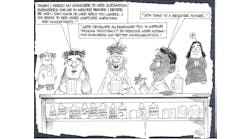The following is a response to the exchange between Sigefredo Nino and Greg McMillan in the May Feedback column.
The letter by Sigifredo Nino and Greg McMillan’s response made it clear to me that there is some confusion about the Lambda tuning method — at least outside my industry (pulp and paper), where is it used in virtually all cases, and where it’s taught and fully embraced.
An excerpt from Greg’s response, with which I agree, was surprising: "I realized about two years ago that if I switch from Lambda tuning rules for self-regulating processes to Lambda tuning rules for integrating processes with derivative action (when the time constant to dead time ratio became greater than three), and I used a Lambda equal to half the dead time, the problem largely goes away."
What’s surprising to me is that this was not known. In the pulp and paper industry, we have very few temperature, concentration and pH loops. Concentration (consistency) control occurs at the outlet of chests, so it has a very small time constant, and pH loops are in some cases handled by something more sophisticated, such as a modified Smith predictor. In the rare cases where we have processes with a large time constant, we do indeed use the rule for integrating processes because we would have very poor performance otherwise. This is generally taught in the Lambda tuning courses, including my own, in the pulp and paper industry, under the category “near-integrating” processes.
My point is that there seems to be plenty of misunderstanding about the tuning method. I feel some obligation to provide some clarity based on my more than 25 years of use.
R. Glenn Givens P.Eng.
Givens Control Engineering Inc.
Burlington, Ontario, Canada



